From the vast desert expanses of the Kalahari Desert to the lush vegetation around the Okavango Delta, Botswana allows you to explore nature to its fullest.
From the north to the south of the country, Botswana is teeming with wildlife, including elephants, hippopotamuses, crocodiles, antelopes, buffaloes, big cats and many others! This, combined with the limited number of visitors that venture out from the main populated centers, makes this country a particularly exceptional destination to discover African fauna.
Although most lodges are often unaffordable, it is possible to travel through nature reserves in your own vehicle and camp in completely open and isolated locations. This may be one of the most memorable experiences we have had within the parks of Southern Africa.
(For greater viewing comfort, double-click on the gallery to open it in full screen mode)
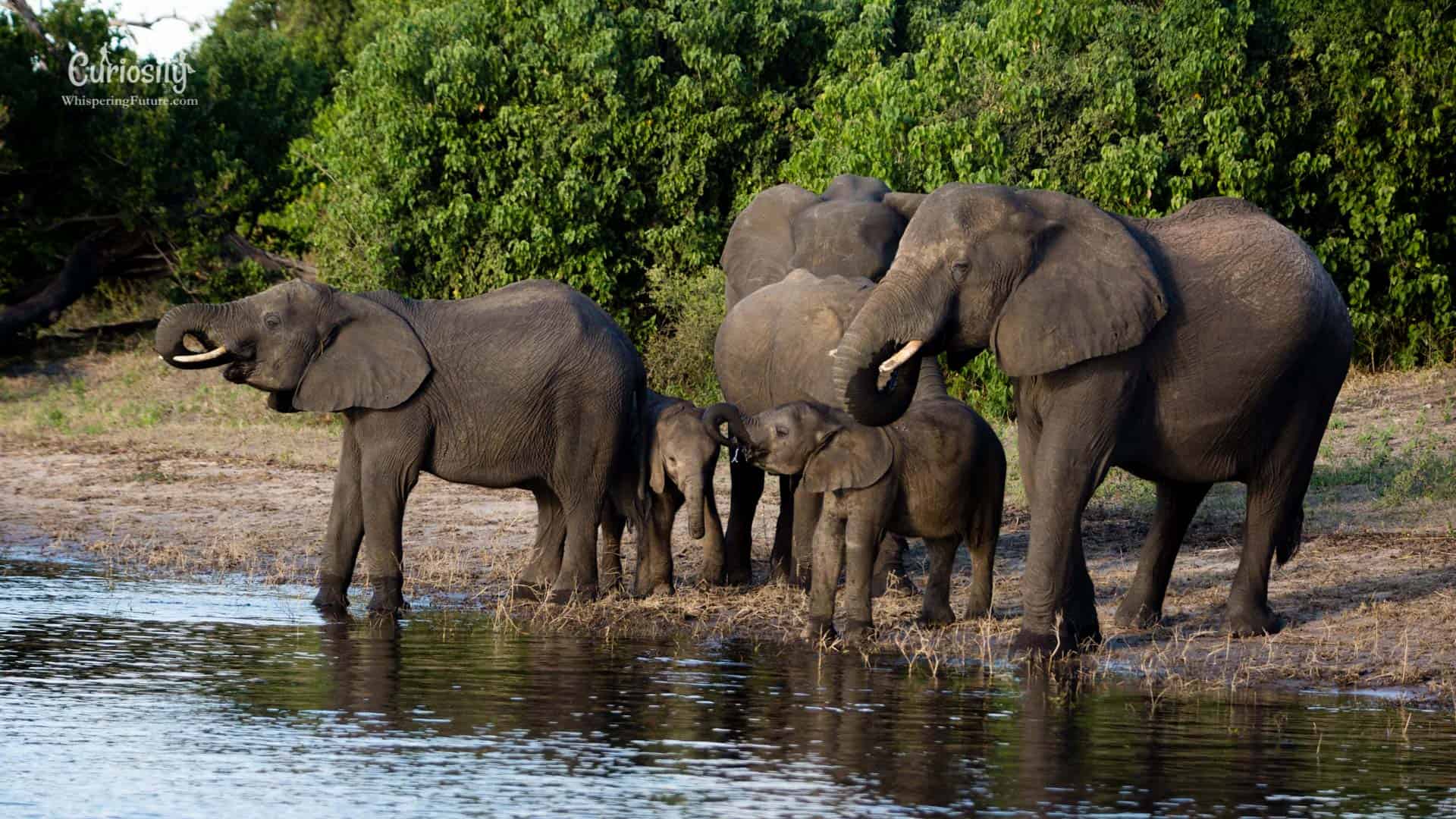

Land of the Sans

Okavango Delta

In the heart
of Southern Africa

Ecosystem
regulators

At a bend
in the path

There is no point
in running

Group lives

Frugal predator

Elephants sanctuary

Chobe River

Land of the Tswana
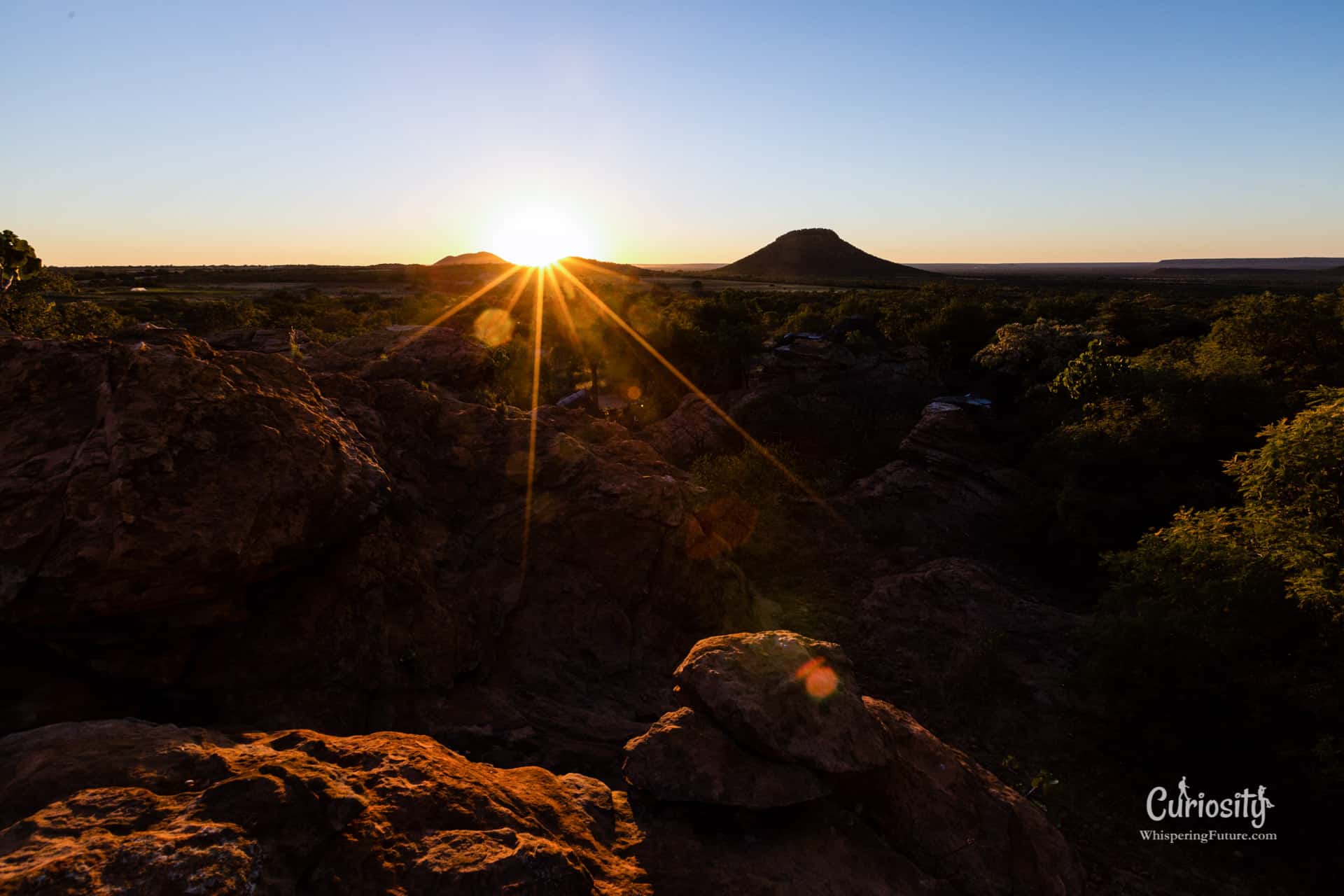 Back to Gallery
Back to GalleryLand of the Tswana

“Botswana” means "Land of the Tswana",
named after the main ethnic group that lives there.
With less than four inhabitants per km2, the country is very sparsely populated,
meaning it’s easy to find yourself alone in its magnificent unspoiled countryside.
17% of the land between the Okavango Delta and the vast Kalahari Desert
(which covers most of Botswanan territory) lies in protected areas.
Aside from its abundant wildlife,
Botswana is also known for its economic and political success,
making it one of the most prosperous countries in Africa.
“Botswana” means "Land of the Tswana",
named after the main ethnic group that lives there.
With less than four inhabitants per km2, the country is very sparsely populated,
meaning it’s easy to find yourself alone in its magnificent unspoiled countryside.
17% of the land between the Okavango Delta and the vast Kalahari Desert
(which covers most of Botswanan territory) lies in protected areas.
Aside from its abundant wildlife,
Botswana is also known for its economic and political success,
making it one of the most prosperous countries in Africa.
Sunset - Serowe
 Back to Gallery
Back to GalleryOn the banks of the Chobe River

The Chobe Riverfront is undoubtedly
the most easily accessible of the country’s many nature reserves.
The river attracts a very large number of animals, mainly elephants,
in addition to the many hippopotamuses and crocodiles that inhabit the waters.
The Chobe Riverfront is undoubtedly
the most easily accessible of the country’s many nature reserves.
The river attracts a very large number of animals, mainly elephants,
in addition to the many hippopotamuses and crocodiles that inhabit the waters.
Herd of elephants - Chobe Riverfront
 Back to Gallery
Back to GalleryElephants sanctuary

Botswana has the largest number of elephants in Africa,
boasting more than 50,000 individuals on its territory.
Most of them are located in Chobe National Park.
Elephants have a limited number of molars
that grow one after the other throughout their lifetimes.
As their last set of teeth come in at around age 50,
elephants are usually killed by malnutrition
following excessive tooth wear.
As they grow older, elephants spend more time in rivers
looking for softer grass to dig their teeth into!
The beauty and accessibility of this site, however,
make it a very popular attraction.
We recommend visiting in low tourist season,
as you’ll be better able to appreciate
the magic of this reserve...
Botswana has the largest number of elephants in Africa,
boasting more than 50,000 individuals on its territory.
Most of them are located in Chobe National Park.
Elephants have a limited number of molars
that grow one after the other throughout their lifetimes.
As their last set of teeth come in at around age 50,
elephants are usually killed by malnutrition
following excessive tooth wear.
As they grow older, elephants spend more time in rivers
looking for softer grass to dig their teeth into!
The beauty and accessibility of this site, however,
make it a very popular attraction.
We recommend visiting in low tourist season,
as you’ll be better able to appreciate
the magic of this reserve...
Elephant and its cattle egret - Chobe River
 Back to Gallery
Back to GalleryCrocodile, a part-time predator

Perfectly silent and motionless, the Nile crocodile,
which can weigh up to 700 kg and measure 4-metres-long,
is able to go completely unnoticed hiding in the water.
Showing only his nostrils and eyes,
he watches for his prey, waiting for the right moment
to pounce on it and drag it down with him to drown it.
Although considered the perfect predator, he is not an insatiable killer, however,
and on average is happy with only 50 meals a year.
This is thanks to his particularly low metabolism
and his strategies for storing and preserving energy.
The crocodile is an ancient species,
having outlived the dinosaurs and survived millions of years of history.
There are a lot of them in the Chobe River waters where there is plenty of prey.
Perfectly silent and motionless, the Nile crocodile,
which can weigh up to 700 kg and measure 4-metres-long,
is able to go completely unnoticed hiding in the water.
Showing only his nostrils and eyes,
he watches for his prey, waiting for the right moment
to pounce on it and drag it down with him to drown it.
Although considered the perfect predator, he is not an insatiable killer, however,
and on average is happy with only 50 meals a year.
This is thanks to his particularly low metabolism
and his strategies for storing and preserving energy.
The crocodile is an ancient species,
having outlived the dinosaurs and survived millions of years of history.
There are a lot of them in the Chobe River waters where there is plenty of prey.
Nile crocodile - Chobe river
 Back to Gallery
Back to GalleryGroup lives
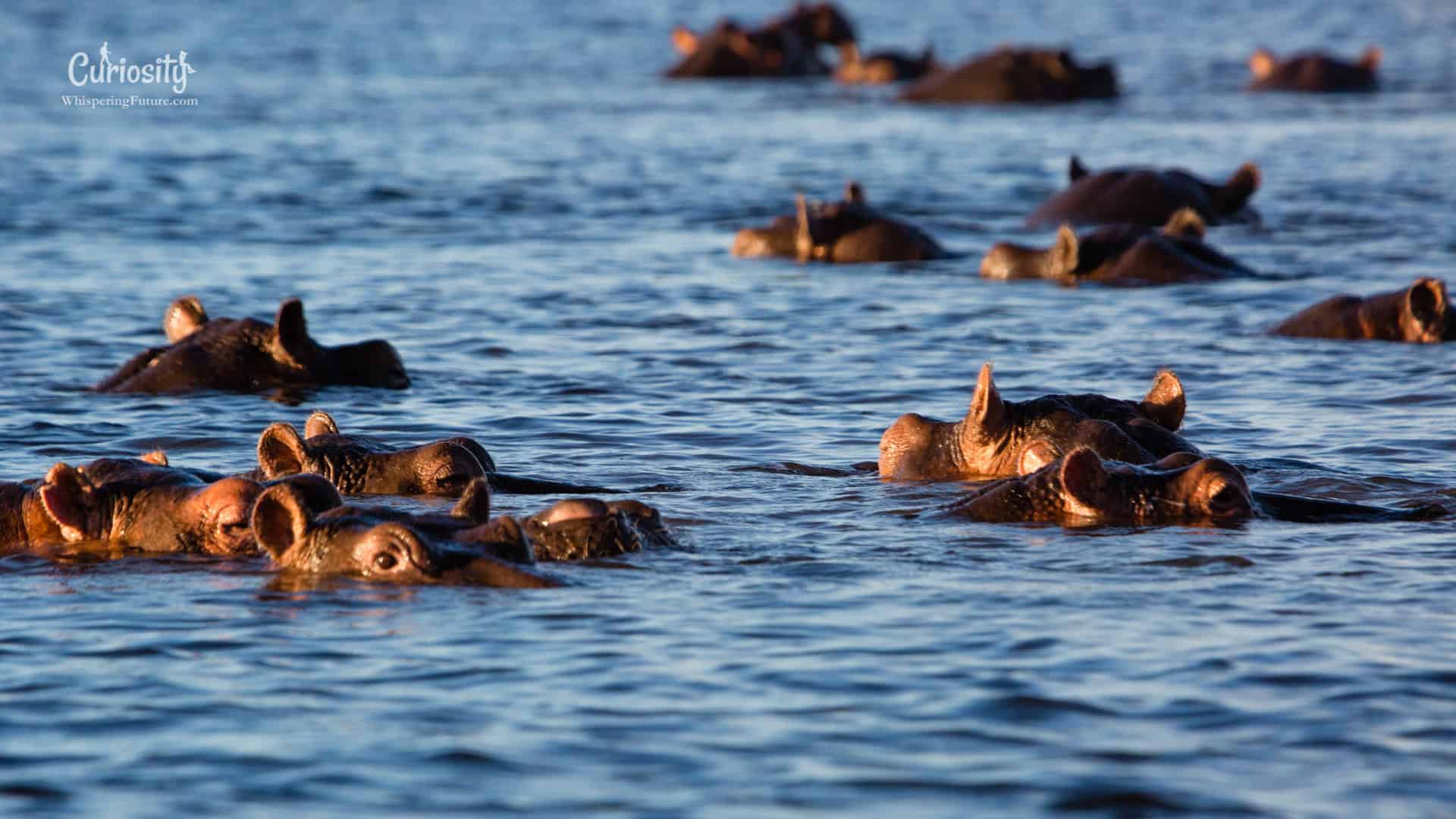
While keeping their distance from each other,
many hippopotamuses share the waters of the Chobe River.
They are very territorial, generally living in herds
of 10 to 15 animals led by a dominant male.
While it may be rare to see them out of the water,
you can still witness a wide range of behaviours
coming from the handful of seemingly calm heads poking out
of the surface: frequent fights, signs of submission between males,
and even what we call “yawning”, where the animals open their jaws at 150° angles
to show off their impressive canine teeth.
While keeping their distance from each other,
many hippopotamuses share the waters of the Chobe River.
They are very territorial, generally living in herds
of 10 to 15 animals led by a dominant male.
While it may be rare to see them out of the water,
you can still witness a wide range of behaviours
coming from the handful of seemingly calm heads poking out
of the surface: frequent fights, signs of submission between males,
and even what we call “yawning”, where the animals open their jaws at 150° angles
to show off their impressive canine teeth.
Group of hippopotamuses - Chobe River
 Back to Gallery
Back to GalleryThere is no point in running
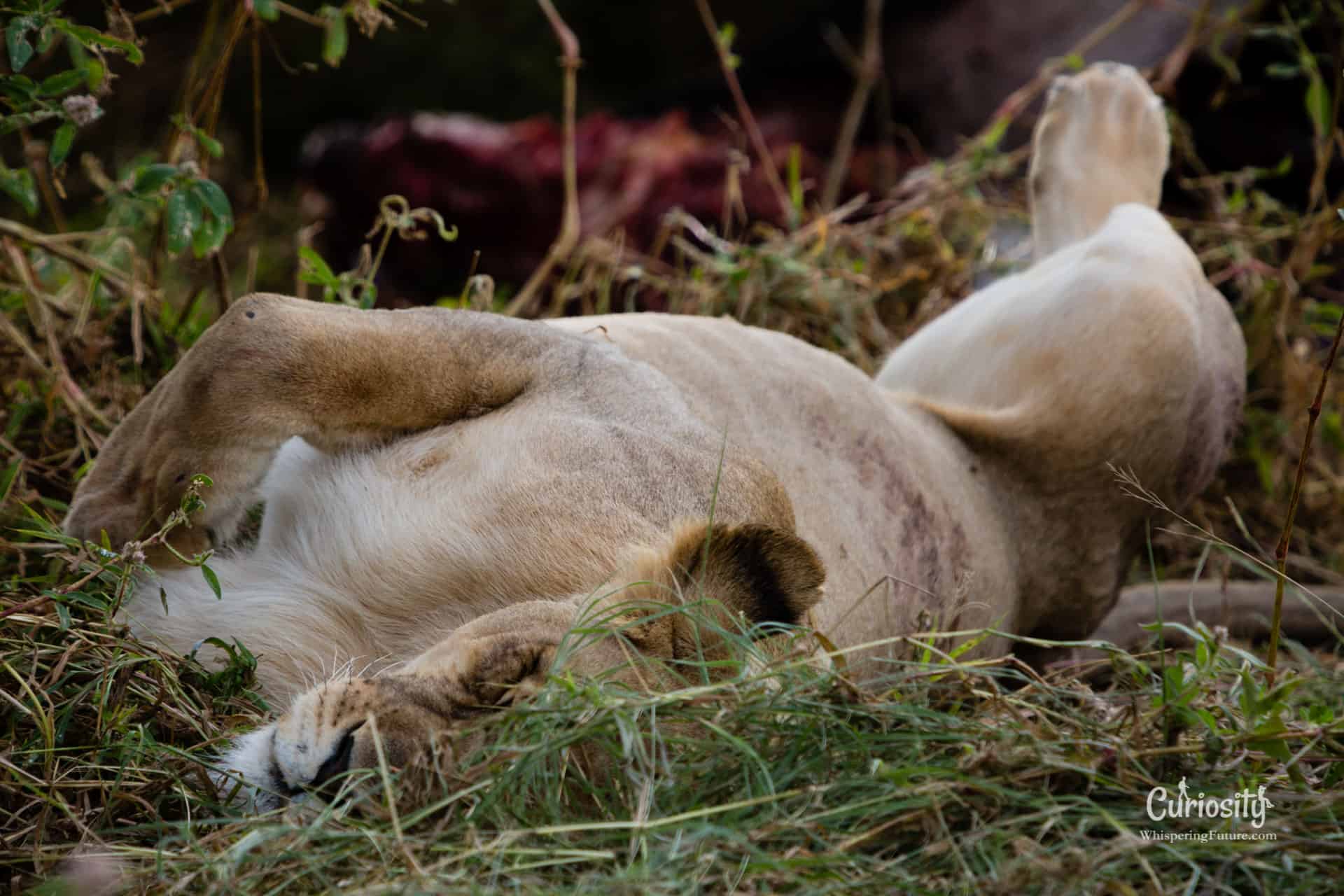
Huge nature reserves like the Kalahari Desert let people observe animals
in their natural environment without restricting their movements or disturb them.
It's up to us to leave them in peace! Luckily, it is entirely possible to see
a very large number of animals without having to chase them or drive off the road.
Big cats in particular do not seem to worry at all about the presence of cars
and can be found just a few metres from the trails.
This was the case for this lioness, who was found resting
next to an oryx carcass after a satisfying meal.
All you have to do is turn off the engine and enjoy the show!
Huge nature reserves like the Kalahari Desert let people observe animals
in their natural environment without restricting their movements or disturb them.
It's up to us to leave them in peace! Luckily, it is entirely possible to see
a very large number of animals without having to chase them or drive off the road.
Big cats in particular do not seem to worry at all about the presence of cars
and can be found just a few metres from the trails.
This was the case for this lioness, who was found resting
next to an oryx carcass after a satisfying meal.
All you have to do is turn off the engine and enjoy the show!
Lioness - Central Kalahari Game Reserve
 Back to Gallery
Back to GalleryAt a bend in the path

Undaunted, this lion proudly sits in the middle of the trail,
unaware of the effect he has on us!
Due to the hot and arid environment of the Kalahari Desert
and the resulting low prey density,
lions in the area generally live in fairly small prides
and have a slightly lower weight than normal.
They are also distinguishable by their magnificent black manes.
It took us a few minutes to realize that another
male was lying a few meters away,
completely hidden by the tall grass.
Does that mean that the rest of the group is nearby?
Undaunted, this lion proudly sits in the middle of the trail,
unaware of the effect he has on us!
Due to the hot and arid environment of the Kalahari Desert
and the resulting low prey density,
lions in the area generally live in fairly small prides
and have a slightly lower weight than normal.
They are also distinguishable by their magnificent black manes.
It took us a few minutes to realize that another
male was lying a few meters away,
completely hidden by the tall grass.
Does that mean that the rest of the group is nearby?
Lion - Central Kalahari Game Reserve
 Back to Gallery
Back to GalleryIn search of harmony
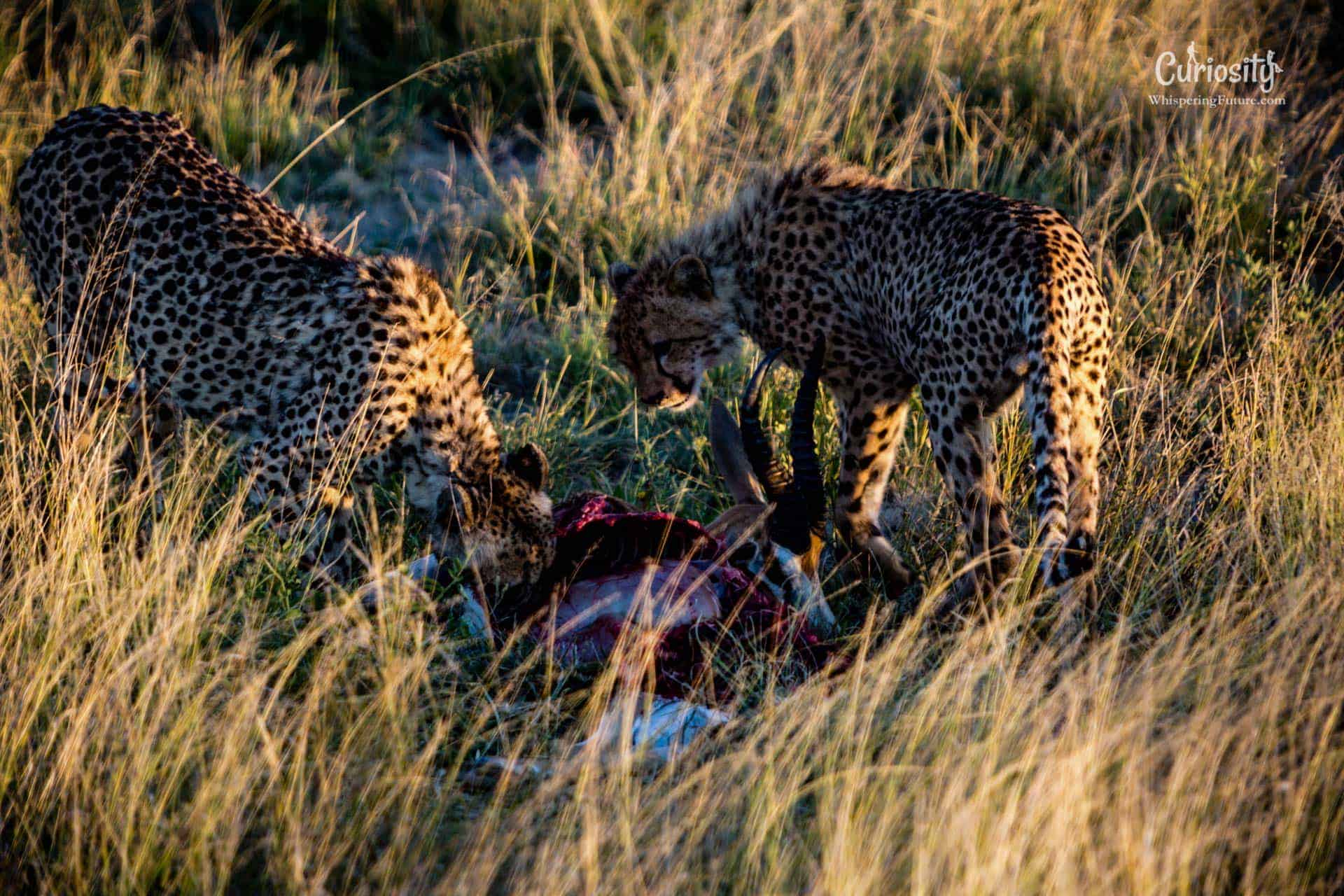
Predators are essential to maintain balance in an area's ecosystem.
By targeting weaker or older prey, they regulate herbivore populations,
prevent the spread of diseases and thus protect biodiversity.
The magnificent cheetah is the fastest of the big cats.
There are now only about 10,000 to 15,000 cheetahs in the wild,
with the highest concentrations in Namibia and Botswana.
Like wolves in Europe, they suffer from the loss of their natural habitats
and are too often considered as "rivals" by humans
who hunt them to protect their livestock.
Predators are essential to maintain balance in an area's ecosystem.
By targeting weaker or older prey, they regulate herbivore populations,
prevent the spread of diseases and thus protect biodiversity.
The magnificent cheetah is the fastest of the big cats.
There are now only about 10,000 to 15,000 cheetahs in the wild,
with the highest concentrations in Namibia and Botswana.
Like wolves in Europe, they suffer from the loss of their natural habitats
and are too often considered as "rivals" by humans
who hunt them to protect their livestock.
Cheetahs eating a springbok - Central Kalahari Game Reserve
 Back to Gallery
Back to GalleryIn the heart of Southern Africa

One thing that really sets Botswana apart
is the lack of fences on its nature reserves and campsites.
Not only does this let animals move about freely,
it also lets you truly feel at one with nature.
Our most memorable experience on an African reserve
was without a doubt sitting alone at sunset around a wood fire,
with only the roars of a few distant lions for company.
One thing that really sets Botswana apart
is the lack of fences on its nature reserves and campsites.
Not only does this let animals move about freely,
it also lets you truly feel at one with nature.
Our most memorable experience on an African reserve
was without a doubt sitting alone at sunset around a wood fire,
with only the roars of a few distant lions for company.
Sunset - Chobe river
 Back to Gallery
Back to GalleryFlooding in the desert

The direct opposite of the giant Kalahari, which covers 70% of the country,
the Okavango River flows abundantly into a part of the desert,
creating the second largest inland delta in the world
and bringing with it an explosion of life.
Numerous plant and animal species, many of which are threatened,
depend on the lagoons and wetlands created by this phenomenon.
These waters, which will never reach the sea,
will then evaporate under the intense heat
to give way to a new cycle a year later...
The direct opposite of the giant Kalahari, which covers 70% of the country,
the Okavango River flows abundantly into a part of the desert,
creating the second largest inland delta in the world
and bringing with it an explosion of life.
Numerous plant and animal species, many of which are threatened,
depend on the lagoons and wetlands created by this phenomenon.
These waters, which will never reach the sea,
will then evaporate under the intense heat
to give way to a new cycle a year later...
Abandoned canoe - Okavango Delta
 Back to Gallery
Back to GalleryThe shadows of the Kalahari

Despite the importance given to species conservation and the country's relative prosperity,
some people persistently suffer injustices from the government
in the name of environmental protection, - but especially from the diamond mining profile.
This is how the San people, hunter-gatherers from Southern Africa, have gradually been driven off their lands,
deprived of their livelihoods and made to live in camps that are totally unsuited to their way of life.
After many years of court proceedings, only a few thousand of them
have been able to return to their territories in the Kalahari Desert.
They still remain victims of discrimination, however,
as hunting and water access permits are still severely restricted
While access to water is prioritized for animals and the tourism industry,
this fundamental right should be available to all people
and under no circumstances should environmental protection be a reason
to exclude people that have lived in harmony with their environment for thousands of years.
Despite the importance given to species conservation and the country's relative prosperity,
some people persistently suffer injustices from the government
in the name of environmental protection, - but especially from the diamond mining profile.
This is how the San people, hunter-gatherers from Southern Africa,
have gradually been driven off their lands, deprived of their livelihoods
and made to live in camps that are totally unsuited to their way of life.
After many years of court proceedings, only a few thousand of them
have been able to return to their territories in the Kalahari Desert.
They still remain victims of discrimination, however,
as hunting and water access permits are still severely restricted
While access to water is prioritized for animals and the tourism industry,
this fundamental right should be available to all people
and under no circumstances should environmental protection be a reason
to exclude people that have lived in harmony with their environment for thousands of years.
Central Kalahari Game Reserve
“Botswana” means “Land of the Tswana”, named after the main ethnic group that lives there. With less than four inhabitants per km2, the country is very sparsely populated, meaning it’s easy to find yourself alone in its magnificent unspoiled countryside.
17% of the land between the Okavango Delta and the vast Kalahari Desert (which covers most of Botswanan territory) lies in protected areas.
Aside from its abundant wildlife, Botswana is also known for its economic and political success, making it one of the most prosperous countries in Africa.
The Chobe Riverfront is undoubtedly the most easily accessible of the country’s many nature reserves.
The river attracts a very large number of animals, mainly elephants, in addition to the many hippopotamuses and crocodiles that inhabit the waters.
Botswana has the largest number of elephants in Africa, boasting more than 50,000 individuals on its territory. Most of them are located in Chobe National Park.
Elephants have a limited number of molars that grow one after the other throughout their lifetimes. As their last set of teeth come in at around age 50, elephants are usually killed by malnutrition following excessive tooth wear.
As they grow older, elephants spend more time in rivers looking for softer grass to dig their teeth into!
The beauty and accessibility of this site, however, make it a very popular attraction. We recommend visiting in low tourist season, as you’ll be better able to appreciate the magic of this reserve.
Perfectly silent and motionless, the Nile crocodile, which can weigh up to 700 kg and measure 4-metres-long, is able to go completely unnoticed hiding in the water. Showing only his nostrils and eyes, he watches for his prey, waiting for the right moment to pounce on it and drag it down with him to drown it.
Although considered the perfect predator, he is not an insatiable killer, however, and on average is happy with only 50 meals a year. This is thanks to his particularly low metabolism and his strategies for storing and preserving energy.
The crocodile is an ancient species, having outlived the dinosaurs and survived millions of years of history. There are a lot of them in the Chobe River waters where there is plenty of prey.
While keeping their distance from each other, many hippopotamuses share the waters of the Chobe River.
They are very territorial, generally living in herds of 10 to 15 animals led by a dominant male.
While it may be rare to see them out of the water, you can still witness a wide range of behaviours coming from the handful of seemingly calm heads poking out of the surface: frequent fights, signs of submission between males, and even what we call “yawning”, where the animals open their jaws at 150° angles to show off their impressive canine teeth.
Huge nature reserves like the Kalahari Desert let people observe animals in their natural environment without restricting their movements or disturb them.
It’s up to us to leave them in peace! Luckily, it is entirely possible to see a very large number of animals without having to chase them or drive off the road.
Big cats in particular do not seem to worry at all about the presence of cars and can be found just a few metres from the trails. This was the case for this lioness, who was found resting next to an oryx carcass after a satisfying meal. All you have to do is turn off the engine and enjoy the show!
Undaunted, this lion proudly sits in the middle of the trail, unaware of the effect he has on us!
Due to the hot and arid environment of the Kalahari Desert and the resulting low prey density, lions in the area generally live in fairly small prides and have a slightly lower weight than normal. They are also distinguishable by their magnificent black manes.
It took us a few minutes to realize that another male was lying a few meters away, completely hidden by the tall grass. Does that mean that the rest of the group is nearby?
Predators are essential to maintain balance in an area’s ecosystem. By targeting weaker or older prey, they regulate herbivore populations, prevent the spread of diseases and thus protect biodiversity.
The magnificent cheetah is the fastest of the big cats. There are now only about 10,000 to 15,000 cheetahs in the wild, with the highest concentrations in Namibia and Botswana.
Like wolves in Europe, they suffer from the loss of their natural habitats and are too often considered as “rivals” by humans who hunt them to protect their livestock.
One thing that really sets Botswana apart is the lack of fences on its nature reserves and campsites. Not only does this let animals move about freely, it also lets you truly feel at one with nature.
Our most memorable experience on an African reserve was without a doubt sitting alone at sunset around a wood fire, with only the roars of a few distant lions for company.
The direct opposite of the giant Kalahari, which covers 70% of the country, the Okavango River flows abundantly into a part of the desert, creating the second largest inland delta in the world and bringing with it an explosion of life.
Numerous plant and animal species, many of which are threatened, depend on the lagoons and wetlands created by this phenomenon.
These waters, which will never reach the sea, will then evaporate under the intense heat to give way to a new cycle a year later.
Despite the importance given to species conservation and the country’s relative prosperity, some people persistently suffer injustices from the government in the name of environmental protection, – but especially from the diamond mining profile.
This is how the San people, hunter-gatherers from Southern Africa, have gradually been driven off their lands, deprived of their livelihoods and made to live in camps that are totally unsuited to their way of life.
After many years of court proceedings, only a few thousand of them have been able to return to their territories in the Kalahari Desert. They still remain victims of discrimination, however, as hunting and water access permits are still severely restricted.
While access to water is prioritized for animals and the tourism industry, this fundamental right should be available to all people and under no circumstances should environmental protection be a reason to exclude people that have lived in harmony with their environment for thousands of years.















